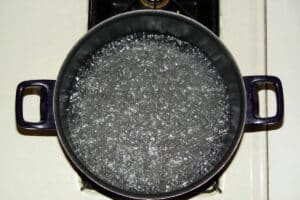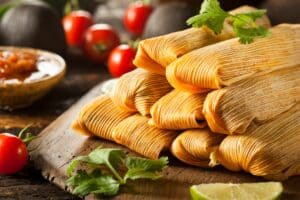We all know how difficult it is to get rice properly cooked in a rice cooker.
Sometimes you can try over and over again with a number of different combinations and still come up with something that looks more like porridge than rice.
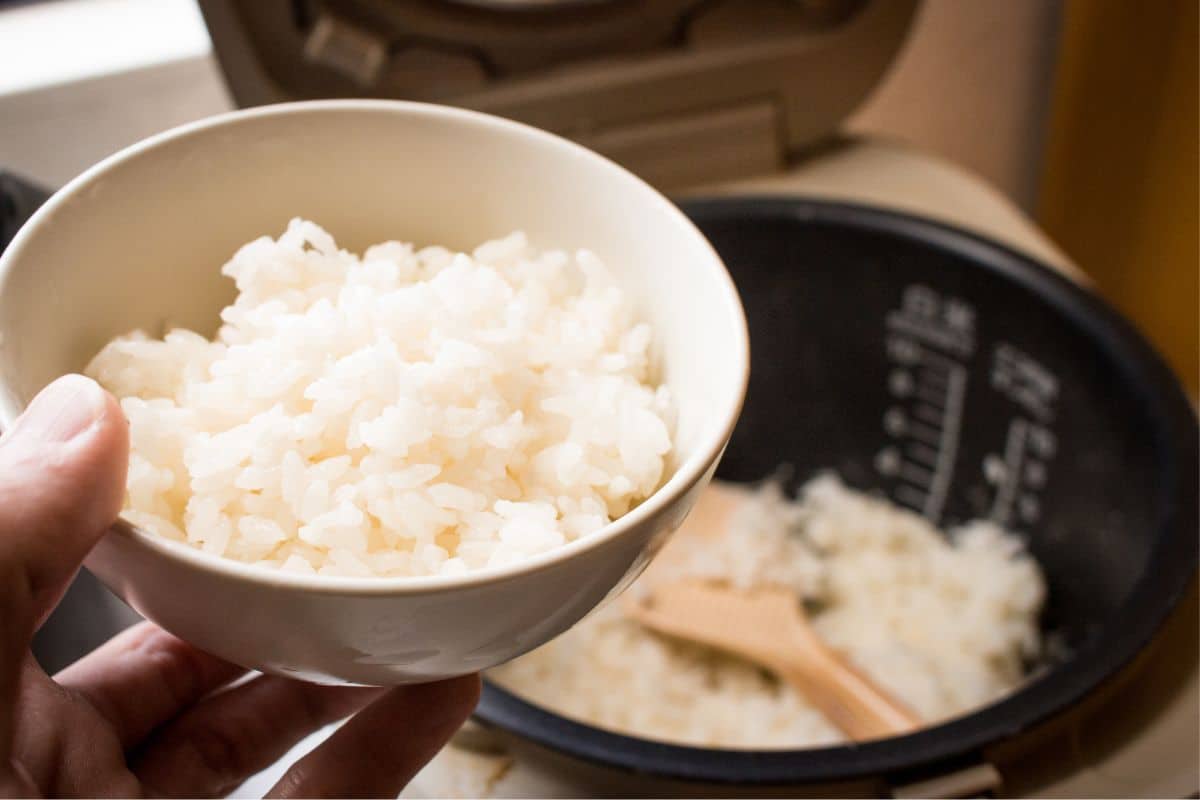
However, luckily there are fixes that you can apply so that your rice doesn’t turn out terrible.
There are different solutions for different types of rice, but one of the main things that you need to bear in mind is the fact that mushy rice is the result of too much water.
So, what is the best way to stop your rice from turning out mushy?
What is the difference between cooking brown rice and cooking white rice? How long do you have to cook jasmine rice?
Well, we have all the information that you need to ensure that your rice turns out perfect as well as cooking tips for rice in general.
Why Does Rice Go Mushy?
One of the main reasons why your rice is mushy is that you have been cooking it in too much water for far too long.
If your rice has too much moisture in it, then you will notice that it has a sort of slimy, gluey texture.
Cooking rice for too long will result in losing its shape and firmness. Even though rice should be soft, it should still retain some semblance of solidity.
Mushy rice can also lose a lot of its flavor through the water, resulting in a much blander end product.
However, you’ll be happy to know that there are ways that you can save your mushy rice and you won’t have to throw it out and start again.
All you need to do is employ different techniques that will help you soak up the water.
One of the other reasons why your rice might end up being mushy time and time again is that you are using poor-quality rice.
The one great thing about rice is that you can get decent quality stuff for very, very cheap. If you are buying cheaper rice, then you might start to notice that it breaks apart a lot easier.
If you are using a rice or pressure cooker for your rice, you’ll also need to make sure that you are setting the right time for the rice that you are using.
For example, white rice needs half the time to cook than brown rice. Also, there is a distinct difference between steaming and cooking, as the former only takes a few minutes.
So, let’s have a look at the rice types and how long you should cook and steam each one. First, we’re going to cover the cooking times of a rice cooker.
How To Cook And Steam Different Types Of Rice In A Rice Cooker
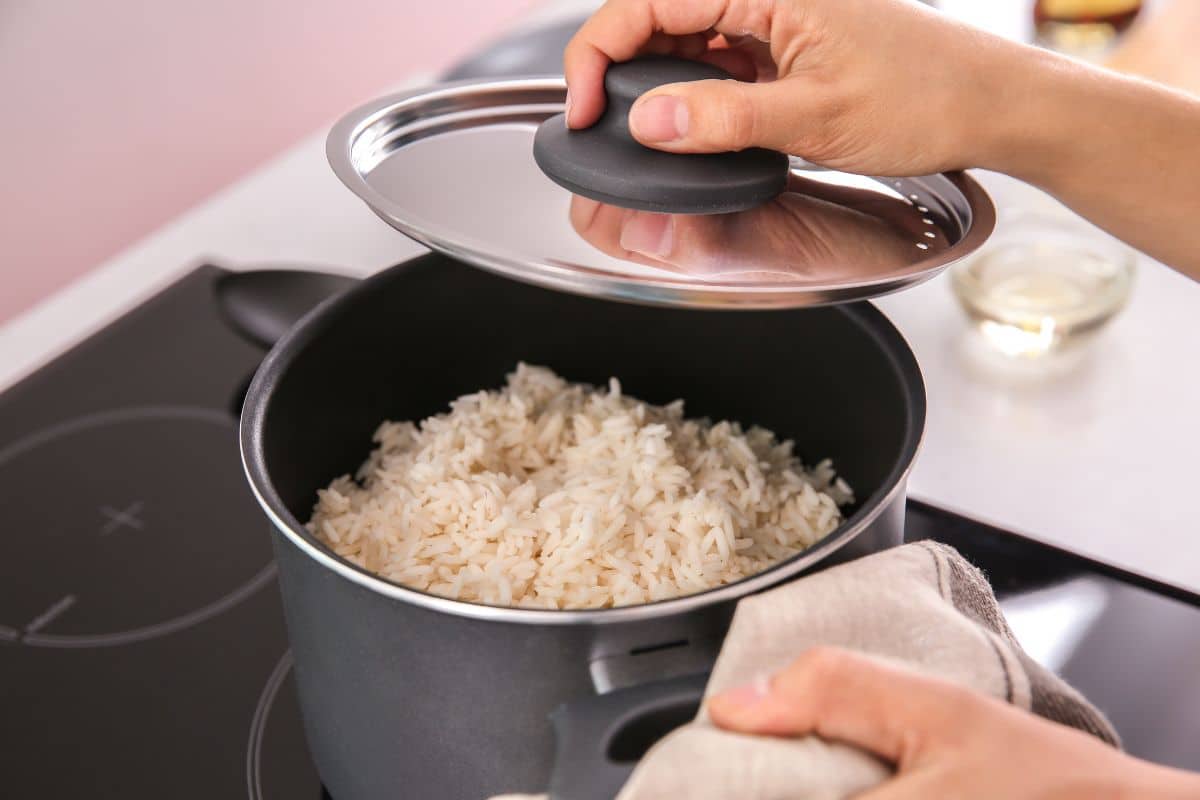
White Rice
- Water/rice Ratio: 1:1
- Cooking time: 20 – 25 minutes
- Steaming time: 5 minutes
Brown Rice
- Water/rice ratio: 1:2.25
- Cooking time: 50 – 60 minutes
- Steaming time: 10 minutes
Wild Rice
- Water/rice ratio: 1:2.25
- Cooking time: 50 – 60 minutes
- Steaming time: 10 minutes
White Basmati Rice
- Water/rice ratio: 1:1.75
- Cooking time: 7 – 10 minutes
- Steaming time: 5 minutes
Brown Basmati Rice
- Water/rice ratio: 1:2
- Cooking time: 10 – 12 minutes
- Steaming time: 5 minutes
Jasmine Rice
- Water/rice ratio: 1:1
- Cooking time: 7 – 10 minutes
- Steaming time: 10 minutes
Arborio Rice
- Water/rice ratio: 1:1
- Cooking time: 15 – 20 minutes
- Steaming time: 10 minutes
However, you should bear in mind that cooking your rice in a rice cooker is very different from cooking your rice in an instant pot or pressure cooker. Here are the times for cooking rice in one of these.
How To Cook And Steam Different Types Of Rice In A Pressure Cooker
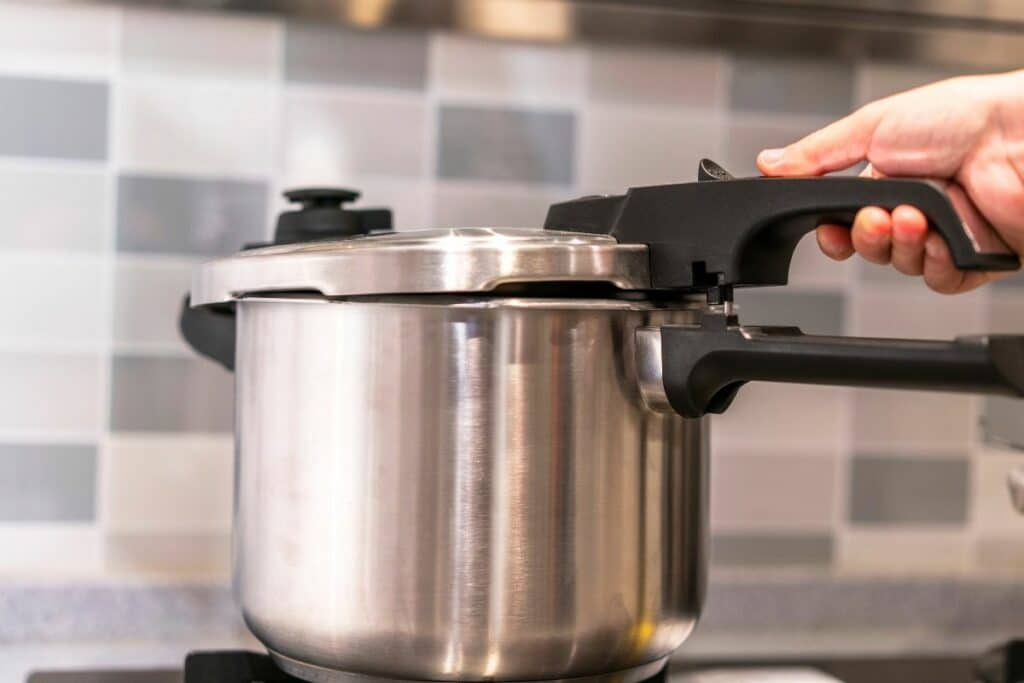
White Rice
- Water/rice ratio: 1:1.25
- Cooking pressure: High
- Cooking time: 4 – 8 minutes
- Steaming time: Natural release
Brown Rice
- Water/rice ratio: 1:1.5
- Cooking pressure: High
- Cooking time: 20 – 22 minutes
- Steaming time: Natural release
Wild Rice
- Water/rice ratio: 1:1.5
- Cooking pressure: High
- Cooking time: 20 – 11 minutes
- Steaming time: Natural release
White Basmati Rice
- Water/rice ratio: 1:1.25
- Cooking pressure: High
- Cooking time: 3 – 4 minutes
- Steaming time: Natural release
Brown Basmati Rice
- Water/rice ratio: 1:1.25
- Cooking pressure: High
- Cooking time: 5 – 6 minutes
- Steaming time: Natural release
Jasmine Rice
- Water/rice ratio: 1:1.25
- Cooking pressure: High
- Cooking time: 3 – 4 minutes
- Steaming time: Natural release
Arborio Rice
- Water/rice ratio: 1:1.5#
- Cooking pressure: High
- Cooking time: 5 – 6 minutes
- Steaming time: Natural release
The Causes And Solutions For Mushy Rice
Here are some bullet-pointed causes and some solutions to avoid mushy rice in the future. If you follow some of these protocols, then you should get rice that looks just like it does in the cookbooks.
- Your rice has not been washed – you should always wash rice before you cook it to get rid of some of the starch. Make sure that you rice it with cold water until it runs from white to clear.
- Too much water in your rice – you’ll need to make sure that you are maintaining the right balance of water depending on what rice you are using. Consult the chart above if you are unsure.
- Cooking time too long – Make sure that when your rice is done that you are allowing it to cool down naturally. Don’t keep warming it after it has finished cooking, as this could result in slushy rice. You should make sure that you switch off your cooker and fluff the rice before serving.
- Poor quality rice – if you are cutting corners on the quality of rice, then you are increasing the chances of it turning out mushy. If you are using low-quality rice, then you should make sure that you are rinsing off all the starch first.
These are some of the main reasons that your rice is turning out mushy. Another reason, although not as common, is that you are leaving the rice to go cold after you have cooked it.
This is why it is important to serve it hot or warm, as the rice separates easier.
How Can You Fix Mushy Rice In Your Rice Or Pressure Cooker?
Just because you are cooking a simple dish such as rice, that doesn’t mean that you should rush it or that you can cook it easily.
Most of the time your rice will turn gooey because there is an excess of starch that oozes out of your rice like a gluey substance.
One of the main reasons that your rice is turning gluey is that you are not checking the consistency.
You’ll need to make sure that you keep track of how much excess water is in your rice and how much you’ll need to drain off or absorb.
Here are some problems that you might encounter with the texture of your rice and how you can fix them quickly without ruining your dish.
1. How To Solve Watery Rice By Draining
If you have noticed that there is excess water in the bottom of your pan of rice, but the topmost part of the rice is very dry, then you can rectify this by using the following method:
- If you are using a rice cooker, then remove the lid.
- Using a sieve, then drain off as much of the excess water as possible. If you do not have a sieve, then create a small gap between the lid and the pot, making sure that there is enough room to lose the water but not the rice.
- Reduce the heat of your rice cooker or instant pot so that it is on low heat.
- Keep cooking the rice slowly until all the water has been cooked away or absorbed.
- Fluff your rice before serving. Make sure that you are serving it hot and that the rice has not clumped together.
Try not to mash the rice too much during these later stages of cooking, it will cause it to break up and again become very mushy. This can cause stickiness and globs to form in your rice.
2. How To Solve Watery Rice With Bread
This is a little-known technique, but one that is very effective in absorbing any excess water. This is the bread technique and all you’ll need is a slice of medium-thickness bread.
Using bread means that you won’t disrupt the cooking time of the rice. You also won’t disturb the rice, which is often the source of why the granules break up.
So, here’s how you solve the dilemma of watery rice with bread:
- Drain off as much of the excess water as you can, either with a sieve or using the lid of the pot you are cooking.
- Turn the heat of your cooking pot as low as possible. Now, take your loaf of bread and place it on top of the rice, although do not press it in.
- Find bread that is completely stale and dry, so that it can soak up as much moisture as possible.
- Replace the lid on the pot and allow it to boil for a bit longer for around a minute or two, although it will depend on how much excess moisture you need to soak up.
- Take the lid off the pot once again and keep cooking for a further 5 minutes or until the bread can absorb no more liquid.
- Fluff the rice and serve it while it is still hot to avoid it clumping.
You can use any type of bread that you like, although we would recommend chunky slices that are stale, as this is the type of bread that will absorb the most moisture.
If you do not have any bread, then you can use dry pasta and it will achieve the same effect.
We found that dry pasta isn’t as good at absorbing excess moisture as bread and it might be difficult to pick out the pasta once it has become saturated.
However, you shouldn’t be frustrated if bread or pasta doesn’t remove all the water in your pan, especially if there is a lot of excess.
But nevertheless, this will help you get rid of some of the moisture, so we would certainly recommend that you try it if all other methods have failed.
3. How To Solve Mushy Rice With An Oven
The oven is perfect for introducing that final blast of heat during the last few minutes of cooking, especially if you are struggling to get rid of that little pool of water at the bottom of the pan.
Sometimes you’ll need to make sure that your rice is dried out before serving.
Here’s how you can use the oven to rectify your overcooked rice:
- Preheat your oven, we would recommend a heat of around 350 degrees Fahrenheit.
- Take your cooked rice and rinse it with cold water until the liquid that runs through the other side is completely clear. This means you have removed the excess starch.
- Take the rice and spoon it out onto some parchment paper. This tray should be lightly greased so that the rice won’t stick once it has been cooked.
- Bake your rice with the oven door open for around 10 minutes. Make sure that you are checking your rice regularly so that it does not burn.
Your rice should be dry and sticky, but it should not clump together.
You can have a few broken grains, but when your rice has started to mush together, that is when it will be much more difficult to salvage.
4. How To Solve Mushy Rice With A Microwave
This is a similar method to the oven, although a microwave cooks much quicker, so you’ll have to keep checking your rice more frequently and put it on a lower timer.
However, a microwave can be a great way of removing a small amount of excess water.
Here’s how you do it:
- Take your cooked rice and rinse it thoroughly with water. You should do this between 3 and 5 times until the water is clear and there is no excess starch.
- Tip out the rinsed rice onto a baking tray. You can also use a microwaveable plate.
- Take your rice and cover it with two layers of paper towels.
- Microwave your rice, checking on it every 30 seconds. You should microwave it on a medium to low heat. Each time you take it out, you should press the paper towel down on top of the rice.
- Microwave your rice for a total of around 5 minutes.
Once you have microwaved your rice, you should notice that the texture is much better, being more solid and dry than before you put it in.
5. How To Fix Rice That Is Breaking Apart
You’ll know that rice has come out at the perfect texture when you can make out each individual granule.
The rice might clump together, but it will fall apart quite easily. What you don’t want is for your rice to form solid balls that do not separate.
There is one method that you can use to save your rice if it breaks apart way too easily and that’s by putting it in the fridge. Refrigeration will help your rice to regain some of its form and restore some of the texture of well-cooked rice.
Here’s how to save your rice using a refrigerator:
- Rinse your rice through a colander or sieve, making sure all the starch has gone and the water is running clear.
- Allow the rice to drip-dry and then place it on parchment paper. Spread out the rice so that there is one single layer across the surface.
- Take the tray of rice and put it on a shelf in the fridge. Leave it in there for around 30 minutes.
- Check to see if the rice is dry. If there are still wet patches, then absorb them with a paper towel. Once this is done, then replace the tray back in the fridge for another 30 minutes.
- While it is cooling, preheat your oven on low to medium heat.
- Take your rice out of the fridge and place it in the oven for around 5 minutes.
- Take your rice out of the oven, fluff and serve.
This is a solid method of saving your rice, although you will need at least an hour to employ this method. If you are rushed for time, then we would suggest using one of the methods we have listed above.
What Happens If Your Rice Is Spoiled
Sometimes no matter how hard you try, you might not be able to use your rice for the intended purpose, either because it is too mushy or it breaks apart way too easily.
But don’t throw away your rice just yet. You can make it into several different dishes, read below to see which ones.
Rice Pudding
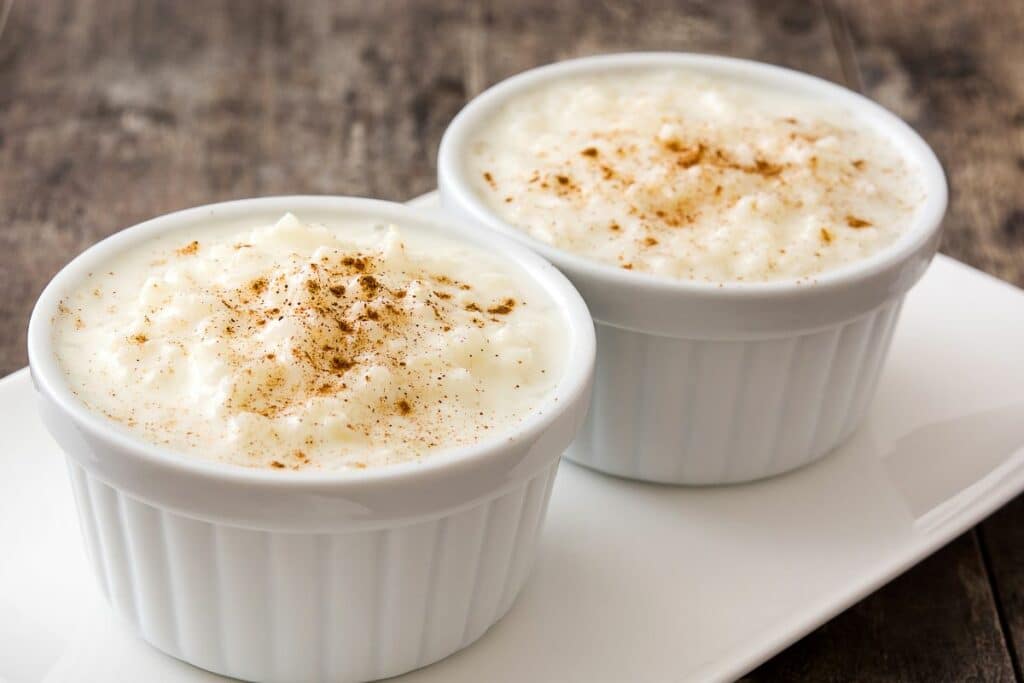
That’s right, if your rice turns out mushy, then this is the perfect texture to make rice pudding from.
All you need to do is add some eggs, sugar, and maybe a few raisins and you have the perfect breakfast snack. Oh, and also don’t forget the milk!
The great thing about rice pudding is that it is vegan, all you need to do is switch out the cow’s milk for oat milk and you have yourself a very delicious non-meat, non-dairy stomach filler.
Teriyaki Rice Cakes
This is another dish that is made with very clumpy rice. You need to make sure that you are rolling your rice into a crisping bag, and forming them into thin tubes.
Once you have done this, then take a cookie cutter and cut out circles, re-rolling the remaining pastry and making as many circles as possible. Now all you need to do is make the sauce to fry them in.
Take some soy sauce, oyster sauce, and a drizzle of honey, and mix them up in a bowl vigorously.
Then heat up a frying pan and coat them in a thin layer of oil (this is because the rice cakes are delicate and will break up if they stick to the pan).
Fry each rice cake for a few minutes, making sure to flip them over regularly. You’ll need to make sure that they are golden brown before you take them out.
Once you have cooked them to your satisfaction, then brush them with the soy sauce concoction that you have made.
They are now ready to eat. For that extra level of authentic Chinese dining, then you should serve these cakes with some dried seaweed.
Rice Soup
This is another amazing way to enjoy mushy rice, drenching it in flavored water that is made with a hearty stock of your choosing (chicken and beef are great choices) along with crunchy vegetables for that extra health factor.
This comes with an amazing texture and if you cook it just right, then the rice will act as a great absorber for all the flavor.
Fried Rice
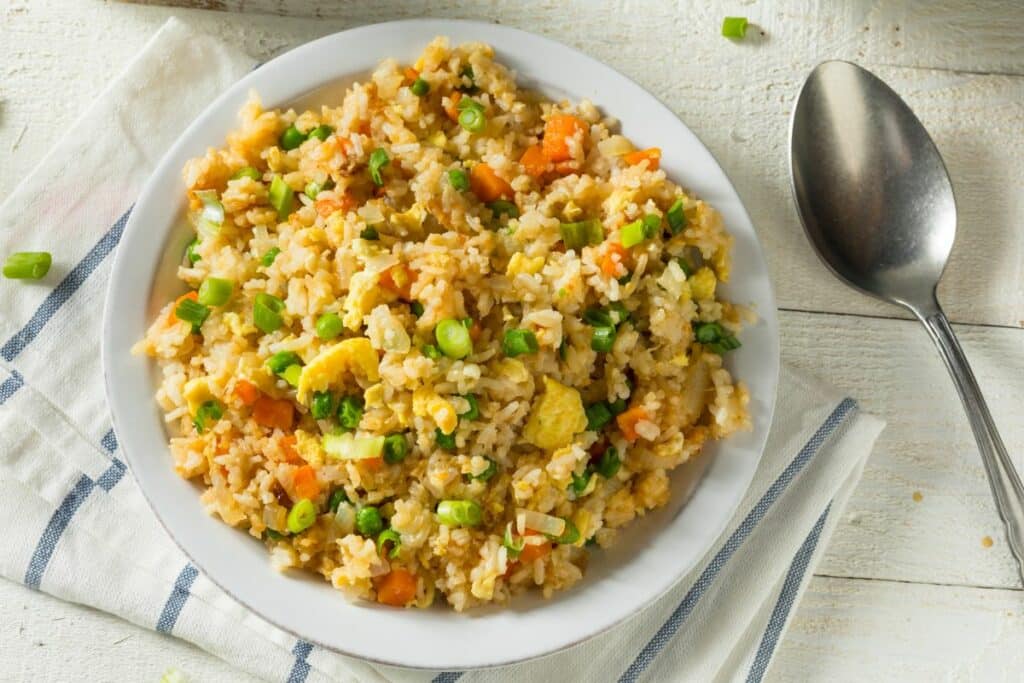
This is the best way to enjoy rice that has clumped together too much to be used as plain boiled rice.
All you need to do is warm up a little oil in your frying pan and cook your rice over medium heat until it turns golden brown.
Frying rice will really bring back some of the flavors that you might have lost in the cooking or steaming process.
You’ll need to keep an eye on your fried rice to make sure it doesn’t burn. You can add some egg during the end of the frying process to make sumptuous egg-fried rice.
You can also make scallops out of fried rice. You can make the batter using eggs and whole milk with some spicy mayonnaise.
Then you’ll have yourself a wonderful dish that contains all the aromas of a traditional Chinese meal.
How To Fix Different Rice Types When They Go Mushy
There are a lot of different varieties of rice, each one with its own optimal cooking time, texture, and flavor.
It’s worth breaking down each one of these rice types and how you can fix them if they go mushy.
Mushy Rice
We have listed a few methods for fixing mushy white or brown rice above.
All you need to do is make sure that you remove the excess moisture, either by draining it off, baking it in the oven, putting it in the refrigerator, or using bread to soak up the water.
If your rice is breaking apart then you can always use it to make dishes like rice soup, rice pudding, and fried rice cakes.
Soggy Rice
If your rice is soggy, then you can also try the draining method. You can also dry by reducing the heat and simply boiling away the water at the bottom of the pan.
The bread technique is also a great way to get rid of the moisture that might pool in the bottom of the pan.
You can use an oven or a microwave to dry out your rice, although you will have to be diligent when you are checking it, as the higher temperatures will burn it.
You’ll need to check the rice more often in the microwave than you would in the oven.
Mushy Brown Rice
Brown rice takes much longer to get softer than white rice, so a lot of people overcompensate by adding a lot more water than they need to.
This results in a longer cooking time, as it will take a while for your rice to evaporate.
Rinsing the brown rice will help to remove some of the starch that could turn your rice into a sticky mess.
This will also help you to avoid your brown rice clumping together.
Mushy Spanish Rice
The ratio of water/rice for Spanish rice should be around 1:2, so make sure that you stick to this when cooking.
However, a lot of people find it hard to judge how much to put in and end up adding a lot more water than they need to.
If your Spanish rice has turned out mushy, then you can restore the original texture by spreading it out on a baking tray and putting it in the oven or the microwave.
You only need to place it in the oven for a short period at a medium to high temperature.
If you are baking your rice in the oven, then this will completely evaporate the excess rice water rather than causing steam that will only circulate back into the rice itself.
Mushy Mexican Rice
The ratio of water/rice in Mexican rice should be roughly the same as Spanish rice, that is 1:2.
When you are cooking or frying Mexican rice, you should add a little bit of oil to the water to ensure that it cooks at a much higher temperature.
You’ll need to make sure that you boil the rice first before reducing the whole thing to a simmer over the course of 15 minutes to half an hour.
You can also bake this in the oven if it has turned out clumpy or soggy. This is a great way to remove built-up moisture.
Soggy Sushi Rice
If your rice is too broken, then you should not make sushi with it. However, if your rice is only slightly cracked and mushy, then you can restore it to the texture that you need.
Simply take it off the boil and add some vinegar while fluffing.
Mushy Jasmine Rice
If you have aromatic rice like Jasmine, then you’ll want to avoid overly rinsing it, as you will lose some of the flavors.
If your Jasmine rice has become clumpy, then you’ll have to put it in cold water and soak it for around 5 minutes.
Then you should take out the rice mixture, rinse it quickly under the tap and then transfer it to a baking tray for reheating.
Mushy Basmati Rice
Again, you don’t want to rinse this rice too much, as you will lose some of its base flavors.
We would recommend that you soak this rice for around a minute before rinsing it lightly in a sieve and then transferring it to a baking tray.
Conclusion
We hope that this guide to saving your mushy rice in the rice or pressure cooker has helped you restore it to its original flavor and texture.


